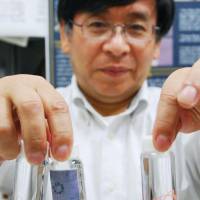A team of researchers led by Makoto Nakamura of Toyama University has developed a device to make superthin threads from live human cells that they hope to turn into organs and blood vessels.
Nakamura, who specializes in regenerative engineering, developed, the device jointly with an Osaka-based machinery company by applying techniques used in textile manufacturing.
The researchers have mixed live human cells with gel and inserted them into the nozzle of a super-thin hole. When they are squeezed out, the cells become a thread as thin as 1/1000 mm in diameter, Nakamura said. The thread can be bundled or woven into three-dimensional objects much like fabric is woven from thread, he added.
"We will be able to avoid transplants if we can create organs from cell-derived threads," Nakamura said.
Nakamura's team has already succeeded in turning rat cells into 1 mm-wide threads. The biggest technical challenge at the moment is keeping the cells alive. While the researchers currently use cells taken from organs, they might start using iPS cells in the future. The team's patent applications are pending.
Nakamura used to be a pediatric surgeon, but turned to regenerative medicine research about 20 years ago with hopes of saving children's lives by using artificial hearts.
In the past, he has worked on developing 3-D bioprinters modeled after ink-jet printers, by spraying tiny cells and mixing them with gel to change their shape.
"I want to help contribute to the development of regenerative medicine from an engineering approach," he said.



